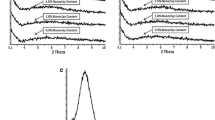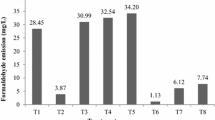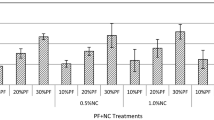Abstract
The utilization of low molecular weight phenol formaldehyde (LmwPF) resin as bulking agent to enhance the dimensional stability of wood brought some disadvantages, such as phenol is derived from non-renewable petrochemicals while formaldehyde is a known carcinogen. Hence, the possibility of using bulking agent made of glyoxalated alkali lignin (GL) incorporated in LmwPF resin to enhance the dimensional stability of wood was investigated. FT-IR spectroscopy showed that polymerization of GL and LmwPF resin was accomplished via the formation of methyl ether (CH2OCH2) bridge. Small amount of crosslinked polymer network was accomplished via the formation of methylene (CH2) bridge. Oven dried jelutong wood was evacuated under vacuum followed by soaking in 15, 20 and 25% concentrations of glyoxalated alkali lignin-low molecular weight phenol formaldehyde (GL-LmwPF) (67% solid of GL: 33% solid of LmwPF based on the total solute content) and LmwPF resins, respectively at ambient temperature for 24 h. The impregnated wood was then cured at 190 °C for 30 min. The weight percent gain (WPG) and dimensional stability in terms of antiswelling efficiency (ASE), moisture excluding efficiency (MEE) and water absorption (WA) as well as leachability of bulking agents were determined and compared with untreated wood and wood treated solely with LmwPF resin. The WPG of GL-LmwPF treated wood was lower than LmwPF treated wood. GL-LmwPF treated wood exhibited positive ASE, but the values were lower compared to LmwPF treated wood. The MEE and WA of GL-LmwPF treated wood were also inferior to LmwPF treated wood and untreated wood. GL-LmwPF resin was leached out from the treated wood whereas no leaching was found for LmwPF treated wood after three leaching cycles in distilled water. The formaldehyde release of GL-LmwPF resin treated wood was 25.76% less than of wood treated with LmwPF resin. Wood treated with 25% GL-LmwPF resin yielded highest ASE value compared to 15 and 20% GL-LmwPF treated wood. Hence, wood treated with 25% GL-LmwPF resin together with external coatings could be used in several end applications such as parquet flooring, paneling and furniture component.













Similar content being viewed by others
References
Abdelwahab NA, Nassar MA (2011) Preparation, optimization and characterization of lignin phenol formaldehyde resin as wood adhesive. Pigm Resin Technol 40(3):169–174
Adawiah MAR, Zaidon A, Izreen FAN, Bakar ES, Hamami SM, Paridah MT (2012) Addition of urea as formaldehyde scavenger of low molecular weight phenol formaldehyde treated compreg wood. J Trop For Sci 24(3):265–274
Alonso MV, Oliet M, Pérez JM, Rodríguez F, Echeverría J (2004) Determination of curing kinetic parameters of lignin–phenol–formaldehyde resol resins by several dynamic differential scanning calorimetry methods. Thermochim Acta 419:161–167
Ang AF (2010) Properties and decay resistance of mahang (Macaranga sp.) treated with phenolic resin and acrylic monomer using vacuum-pressure process. Dissertation, Universiti Putra Malaysia
Ang AF, Zaidon A, Bakar ES, Ibrahim NA (2015a) Characterisation of sequential solvent fractionation and base-catalysed depolymerisation of treated alkali lignin. BioResources 10(3):4137–4151
Ang AF, Zaidon A, Bakar ES, Ibrahim NA (2015b) Characterization and optimization of the glyoxalation of a methanol-fractionated alkali lignin using response surface methodology. BioResources 10(3):4795–4810
Ariffin WTW, Koh MP, Mustafa MT (1992) Improved rattan through phenolic resin impregnation—a preliminary study. J Trop For Sci 5(4):485–491
Ashaari Z, Barnes HM, Lyon DE, Vasishth RC, Nicholas DD (1990) Effect of aqueous polymer treatments on wood properties. Part I: treatability and dimension stability. IRG/WP/3610
Baysal E, Ozaki SK, Yalinkilic MK (2004) Dimensional stabilization of wood treated with furfuryl alcohol catalysed by borates. Wood Sci Technol 38(6):405–415
Cavdar AD, Kalaycioglu H, Hiziroglu S (2008) Some of the properties of oriented strandboard manufactured using kraft lignin phenolic resin. J Mater Process Tech 202(1–3):559–563
Cetin NS, Ozmen N (2002) Use of organosolv lignin in phenol–formaldehyde resins for particleboard production. Part I: organosolv lignin modified resins. Int J Adhes Adhes 22(6):477–480
Deka M, Saikia CN (2000) Chemical modification of wood with thermosetting resin: effect on dimensional stability and strength property. Bioresource Technol 73(2):179–181
El Mansouri NE, Yuan QL, Huang FR (2011) Study of chemical modification of alkaline lignin by the glyoxalation reaction. BioResources 6(4):4523–4536
EN 717-3 (1996) Wood-based panels. Determination of formaldehyde release. Part 3: formaldehyde release by the flask method European Committee for Standardization, Brussels, Belgium
Furuno T, Imamura Y, Kajita H (2004) The modification of wood by treatment with low molecular weight phenol–formaldehyde resin: a properties enhancement with neutralized phenolic-resin and resin penetration into wood cell walls. Wood Sci Technol 37(5):349–361
Ibrahim MNM, Ghani AM, Nen N (2007) Formulation of lignin phenol formaldehyde resins as a wood adhesive. Malays J Anal Sci 11(1):213–218
Inoue M, Norimoto M, Tanahashi M, Rowell RM (1993) Fixation of compressed wood using melamine–formaldehyde resin. Wood Fiber Sci 25(4):404–410
Izreen FAN, Zaidon A, Adawiah MAR, Bakar ES, Paridah MT, Hamami SM, Anwar UMK (2011) Enhancing the properties of low density hardwood Dyera costulata through impregnation with phenolic resin admixed with formaldehyde scavenger. J Appl Sci 11(20):3474–3481
Johnson SE, Kamke FA (1992) Quantitative analysis of gross adhesive penetration in wood using fluorescence microscopy. J Adhesion 40(1):47–61
Johnson SE, Kamke FA (1994) Characteristics of phenol–formaldehyde adhesive bonds in steam injection pressed flakeboard. Wood Fiber Sci 26(2):259–269
Kajita H, Imamura Y (1991) Improvement of physical and biological properties of particleboards by impregnation with phenolic resin. Wood Sci Technol 26(1):63–70
Kamke FA, Lee JN (2007) Adhesive penetration in wood—a review. Wood Fiber Sci 39(2):205–220
Khan MA, Ashraf SM (2007) Studies on thermal characterization of lignin substituted phenol formaldehyde resin as wood adhesives. J Therm Anal Calorim 89(3):993–1000
Kunaver M, Medved S, Čuk N, Jasiukaitytė E, Poljanšek I, Strnad T (2010) Application of liquefied wood as a new particle board adhesive system. Bioresource Technol 101(4):1361–1368
Leemon NF, Ashaari Z, Uyup MKA, Bakar ES, Tahir PM, Saliman MAR, Ghani MA, Lee SH (2015) Characterisation of phenolic resin and nanoclay admixture and its effect on impreg wood. Wood Sci Technol 49(6):1209–1224
Michelle AJ, Watson AJ, Higgins HG (1965) An infrared spectroscopic study of delignification Eucalyptus regnans. Tappi 48(9):520–532
Ohmae K, Minato K, Norimoto M (2002) The analysis of dimensional changes due to chemical treatments and water soaking for hinoki (Chamaecyparis obtusa) wood. Holzforschung 56(1):98–102
Paridah MT, Ong LL, Zaidon A, Rahim S, Anwar UMK (2006) Improving the dimensional stability of multilayered strand board through resin impregnation. J Trop For Sci 18(3):166–172
Pizzi A (2003) Natural phenolic adhesives II: lignin. In: Pizzi A, Mittal KL (eds) Handbook of adhesive technology, revised and expanded, 2nd edn. CRC, Boca Raton, pp 589–598
Poljanšek I, Krajnc M (2005) Characterization of phenol–formaldehyde prepolymer resins by in line FT-IR spectroscopy. Acta Chim Slov 52(3):238–244
Rowell RM, Banks WB (1985) Water repellency and dimensional stability of wood. General Technical Report FPL-50. Madison, WI: US Department of Agriculture, Forest Service, Forest Product Laboratory. Wisconsin
Rowell RM, Ellis WD (1978) Determination of dimensional stabilization of wood using the water-soak method. Wood Fiber Sci 10(2):104–111
Rowell RM, Konkol P (1987) Treatments that enhance physical properties of wood. General Technical Report FPL-GTR-55. Madison, US Department of Agriculture, Forest Service, Forest Product Laboratory. Wisconsin
Rowell RM, Youngs RL (1981) Dimensional stabilization of wood in use. US For. Serv., For. Prod. Res. Note FPL—0243. Forest Product Laboratory, Wisconsin
Ryu JY, Takahashi M, Imamura Y, Sato T (1991) Biological resistance of phenol-resin treated wood. Mokuzai Gakkaishi 37(9):852–858
Shams MI, Yano H, Endou K (2004) Compressive deformation of wood impregnated with low molecular weight phenol formaldehyde (PF) resin I: effects of pressing pressure and pressure holding. J Wood Sci 50(4):337–342
Singh M, Kumar V (2009) Preparation and characterization of melamine–formaldehyde–polyvinylpyrrolidone polymer resin for better industrial uses over melamine resins. J Appl Polym Sci 114(3):1870–1878
Soljacic I, Katovic D (1988) The effect of heating on the release of formaldehyde from durable-press finished fabrics. Color Technol 104(10):384–386
Stamm AJ (1964) Wood and cellulose science. Ronal Press, New York
Tejado A, Peña C, Labidi J, Echeverria JM, Mondragon I (2007) Physico-chemical characterization of lignins from different sources for use in phenol–formaldehyde resin synthesis. Bioresour Technol 98(8):1655–1663
Wahab NHA, Tahir PM, Yeoh BH, Ashaari Z, Yunus NYM, Uyup MKA, Shahri MH (2012) Adhesion characteristics of phenol formaldehyde pre-preg oil palm stem veneers. BioResources 7(4):4545–4562
Zhao Y (2013) Development of bio-based phenol formaldehyde resol resins using mountain pine beetle infested lodgepole pine barks. Dissertation, University of Toronto
Author information
Authors and Affiliations
Corresponding author
Rights and permissions
About this article
Cite this article
Ang, A.F., Ashaari, Z., Bakar, E.S. et al. Possibility of enhancing the dimensional stability of jelutong (Dyera costulata) wood using glyoxalated alkali lignin-phenolic resin as bulking agent. Eur. J. Wood Prod. 76, 269–282 (2018). https://doi.org/10.1007/s00107-016-1139-6
Received:
Published:
Issue Date:
DOI: https://doi.org/10.1007/s00107-016-1139-6




